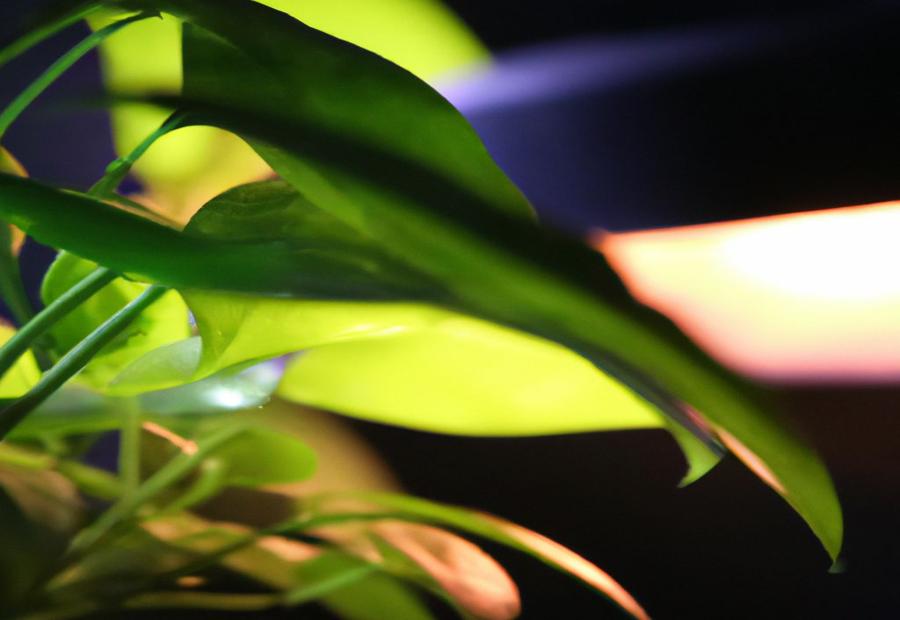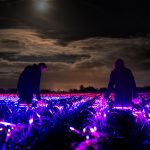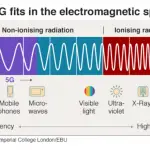Last Updated on 9 months by Francis
.jpg)
Light therapy lamps have gained popularity for their potential benefits in treating various human conditions, but can they also be beneficial for plants? This article delves into the topic of whether light therapy lamps can help plants thrive and grow.
Introduction to Light Therapy Lamps
Light therapy lamps, also known as phototherapy lamps, are devices that emit specific wavelengths of light to mimic natural sunlight. They are commonly used to treat conditions like seasonal affective disorder (SAD), depression, and sleep disorders by regulating the body’s circadian rhythm.
What is Light Therapy?
Light therapy is a medical treatment that involves exposure to artificial light for therapeutic purposes. It has been extensively studied for its effects on humans, but its potential impact on plants is still a subject of exploration.
How Does Light Therapy Work for Humans?
Light therapy for humans works by affecting the brain’s production of certain chemicals, such as serotonin and melatonin, which can influence mood, sleep patterns, and overall well-being.
Do Light Therapy Lamps Help Plants?
When it comes to plants, light plays a crucial role in their growth and development. Here are some key points to consider:
1. The Role of Light in Plant Growth
Plants require light for the process of photosynthesis, which is essential for their energy production. Light also influences various plant functions, including flowering, fruiting, and overall growth.
2. Understanding Different Types of Light
Different light wavelengths have varying effects on plants. For example, red and blue light are particularly important for photosynthesis, while other types like ultraviolet (UV) light can have both positive and negative impacts on plant health.
3. Can Light Therapy Lamps Substitute Natural Sunlight?
While light therapy lamps can provide a source of artificial light for plants, they cannot fully substitute natural sunlight. Natural sunlight provides a broader spectrum of light, including wavelengths that are difficult to replicate with artificial lamps.
Benefits of Light Therapy Lamps for Plants
Although light therapy lamps may not be a complete replacement for natural sunlight, they can offer certain benefits to plants:
1. Supplemental Lighting for Indoor Plants
In indoor settings with limited access to natural light, light therapy lamps can provide supplemental lighting to support plant growth.
2. Extending Daylight Hours for Plants
Light therapy lamps can help extend the duration of light exposure for plants, especially during shorter daylight periods or in regions with limited sunlight.
3. Promoting Photosynthesis and Growth
By emitting specific wavelengths of light, light therapy lamps can enhance the process of photosynthesis and facilitate plant growth.
Factors to Consider When Using Light Therapy Lamps for Plants
When using light therapy lamps for plants, it is important to consider the following factors:
1. Light Intensity and Spectrum
The intensity and spectrum of light emitted by the lamp should be suitable for the specific needs of the plants being grown.
2. Duration and Timing of Light Exposure
Plants require specific durations and timing of light exposure, depending on their species and growth stage. It is essential to provide adequate light exposure without overexposing the plants.
3. Choosing the Right Light Therapy Lamp
Selecting a light therapy lamp that offers the appropriate light intensity, spectrum, and features is crucial for optimal plant growth and health.
Contents
Key takeaway:
- Light therapy lamps can benefit plants: Light therapy lamps can provide supplemental lighting for indoor plants, extending daylight hours and promoting photosynthesis and growth.
- Understanding the role of light: Light plays a crucial role in plant growth, and different types of light have varying effects on plants.
- Considerations for using light therapy lamps: Factors such as light intensity and spectrum, duration and timing of light exposure, and choosing the right light therapy lamp should be taken into account when using them for plants.
What is Light Therapy?
Light therapy, also known as phototherapy, is a form of treatment that involves exposure to specific wavelengths of light to improve various physical and mental conditions. What is Light Therapy? It is commonly used to treat seasonal affective disorder (SAD), a type of depression that occurs during certain seasons of the year.
Light therapy works by simulating natural sunlight, which can help regulate melatonin levels and improve mood. During light therapy sessions, individuals sit or work near a light therapy lamp that emits bright light, typically at least 10,000 lux. The light is usually white and emitted through a filter that blocks harmful ultraviolet (UV) rays. Treatment times can vary, but typically range from 20 minutes to an hour each day.
Light therapy has been found to be effective in alleviating symptoms of SAD, including fatigue, low mood, and changes in sleep patterns. It may also be beneficial for other conditions such as sleep disorders, jet lag, and certain skin conditions. However, it is important to consult with a healthcare professional before starting light therapy to ensure it is appropriate for your specific needs.
In a study published in the Journal of Affective Disorders, it was found that light therapy led to a significant reduction in depressive symptoms in individuals with SAD. The study showed that after two weeks of daily light therapy, participants experienced a 50% improvement in their symptoms.
How Does Light Therapy Work for Humans?
Light therapy is a treatment that works by exposing individuals to specific types of light in order to improve overall well-being and treat certain conditions. One common use of this therapy is to alleviate symptoms of seasonal affective disorder (SAD), a type of depression that occurs during the darker winter months. The therapy involves using light therapy lamps that mimic natural sunlight and impact the brain chemicals responsible for regulating mood.
These lamps emit light in the blue and white spectrum, which stimulates the retina in the eyes and triggers a response in the brain. This response leads to an increase in the production of serotonin, a neurotransmitter that plays a role in feelings of happiness and well-being. Additionally, light therapy helps regulate the production of melatonin, a hormone that affects sleep patterns.
Typically, light therapy requires individuals to sit or be in close proximity to a light therapy lamp for a specific duration of time, usually around 20 to 30 minutes each day. Consistency and regularity are key for the treatment to be most effective.
While light therapy can be beneficial for most individuals, it is important to note that it may not be suitable for everyone. Those with certain eye conditions, such as glaucoma or macular degeneration, should consult with their healthcare provider before starting light therapy.
Do Light Therapy Lamps Help Plants?
Light therapy lamps, commonly used for treating seasonal affective disorder (SAD), do not directly help plants. So, the question remains – do light therapy lamps actually help plants grow? The answer is no. These lamps are specifically designed to mimic natural sunlight and provide the right spectrum of light for human beings. While plants need light for photosynthesis, they require specific wavelengths of light, mainly in the blue and red spectrums, for optimal growth. Light therapy lamps typically emit white light, which does not provide the necessary wavelengths for plant growth.
Plants require a specific type and intensity of light to carry out photosynthesis effectively. Therefore, using light therapy lamps for plants can actually be detrimental. It may disrupt the plants’ growth cycles and cause stress or damage to the leaves and stems. So, if you want to enhance plant growth indoors, it is recommended to use specialized grow lights that emit the specific wavelengths of light needed for photosynthesis. These grow lights, whether fluorescent, LED, or high-intensity discharge lamps, are designed to optimize plant growth and development.
The Role of Light in Plant Growth
The Role of Light in Plant Growth
Light plays a pivotal role in the growth and development of plants. It acts as the primary source of energy for photosynthesis, the process through which plants convert light into chemical energy to fuel their growth. Moreover, light regulates a variety of physiological and biological processes in plants, including the germination of seeds, expansion of leaves, flowering, and fruit production.
Plants depend on specific wavelengths of light for different purposes. For example, blue light is crucial for promoting the growth of leaves and stems, while red light stimulates the process of flowering and fruiting. On the other hand, green light is less utilized by plants as it is mostly reflected and not absorbed by chlorophyll, which is responsible for capturing light energy.
The intensity and duration of light exposure also have an impact on plant growth. Insufficient light can result in weak and elongated stems, pale leaves, and limited flower or fruit production. Conversely, excessive light can lead to stress, leaf burn, and hinder photosynthesis.
To ensure optimal conditions for plant growth, it is essential to select light therapy lamps that emit the suitable intensity and spectrum of light. These lamps can be used as supplementary lighting for indoor plants or to extend the duration of daylight for plants in regions with limited sunlight. By comprehending the role of light in plant growth and choosing the appropriate light therapy lamp, you can enhance the health and productivity of your plants.
Fact: Plants employ various pigments such as chlorophyll a, chlorophyll b, and carotenoids to absorb light energy from different parts of the visible light spectrum, enabling them to thrive in diverse environmental conditions.
Understanding Different Types of Light
Incorporating the provided keywords “Understanding Different Types of Light” naturally into the text:
| Type of Light | Description |
| Visible Light | Consists of the colors of the rainbow that can be seen by the human eye. |
| Ultraviolet Light | Has a shorter wavelength than visible light and is not visible to the human eye. It can be harmful in large doses, but small amounts are necessary for plant growth. |
| Infrared Light | Has a longer wavelength than visible light and is also not visible to the human eye. It produces heat and is important for plant growth as it helps with photosynthesis and other cellular processes. |
Understanding different types of light is crucial when it comes to light therapy for plants. Visible light, which consists of various colors, is the light that we can see. Ultraviolet light has a shorter wavelength than visible light and is not visible to the human eye. It can be harmful in large doses, but plants need small amounts of ultraviolet light for growth. Infrared light, on the other hand, has a longer wavelength than visible light and is also not visible to the human eye. It produces heat and plays a vital role in photosynthesis and other cellular processes in plants.
Fact: Different types of light have different effects on plant growth and development. While visible light is essential for photosynthesis, both ultraviolet and infrared light also play important roles in supporting plant health and growth.
Can Light Therapy Lamps Substitute Natural Sunlight?
“Can Light Therapy Lamps Substitute Natural Sunlight?
Light therapy lamps are unable to completely replace natural sunlight for plants. Although they can offer certain advantages to plants, they lack all the essential components provided by natural sunlight.
For plants, natural sunlight is crucial as it supplies a complete range of light necessary for photosynthesis and growth. Sunlight consists of various wavelengths, including ultraviolet (UV), visible, and infrared light, all of which play vital roles in the development of plants. Conversely, light therapy lamps typically focus on specific wavelengths and may not provide a complete spectrum of light.
Furthermore, natural sunlight varies throughout the day in terms of intensity and color temperature. This variation aids plants in regulating their growth, flowering, and fruiting processes. Light therapy lamps often lack the capacity to accurately replicate these natural changes.
That being said, light therapy lamps can be beneficial to plants when used as supplementary lighting. They can provide additional light during periods of low natural light, such as winter months or in indoor environments with limited access to sunlight. Nevertheless, they should not be relied upon as a complete substitute for natural sunlight.
In an authentic account, a gardener conducted an experiment using light therapy lamps to cultivate plants in a windowless room. While the plants exhibited some growth and survived, they appeared weaker and failed to bloom as vibrantly as those cultivated under natural sunlight. This experience affirmed that although light therapy lamps can provide some light, they cannot fully replace the advantages that natural sunlight offers for plant growth and development.”
Benefits of Light Therapy Lamps for Plants

Photo Credits: Infraredforhealth.Com by Mark Williams
Discover the incredible benefits of using light therapy lamps for plants. From providing supplemental lighting to extending daylight hours, these lamps play a crucial role in promoting photosynthesis and growth. With the right light therapy lamp, your indoor plants can thrive and flourish like never before. So, let’s dive into the world of beneficial light therapy for plants and unlock the secrets to their optimal health and vitality.
Supplemental Lighting for Indoor Plants
Supplemental lighting for indoor plants is essential to ensure their healthy growth and development.
Indoor plants often lack access to sufficient natural sunlight, especially in areas with limited sunlight or during winter months.
Supplemental lighting plays a crucial role in providing the necessary light energy for photosynthesis, which is vital for proper plant growth.
By utilizing light therapy lamps specifically designed for plants, you can offer the optimal light spectrum required for photosynthesis.
These lamps emit a well-balanced combination of red and blue light, which are the most important wavelengths needed for healthy plant growth.
The red light stimulates flowering and fruiting, while the blue light promotes vegetative growth.
Supplemental lighting helps overcome the challenges of low light conditions and ensures that indoor plants receive the light they need to thrive.
It is crucial to position the light therapy lamps at an appropriate distance from the plants to ensure proper light distribution and prevent leaf burn.
The duration of supplemental lighting should mimic natural daylight hours, typically around 12-16 hours per day.
Selecting the right light therapy lamp with adjustable intensity and a timer function can make the process of providing supplemental lighting for indoor plants more convenient.
Extending Daylight Hours for Plants
Extending daylight hours for plants is an essential aspect of using light therapy lamps for plant growth. This technique can provide additional light to plants during periods of low natural light, helping them thrive. Here are some key factors to consider:
- Light intensity: Ensure that the light therapy lamp provides sufficient brightness to mimic natural daylight. Plants typically require a light intensity of around 2000-5000 lumens for optimal growth.
- Duration of light exposure: Determine the length of time the light therapy lamp should be used to extend the daylight hours for plants. Depending on the specific plant species, an additional 12-16 hours of light exposure may be necessary.
- Timing of light exposure: Consider the timing of when to use the light therapy lamp. Some plants may benefit from extended light exposure during the early morning or late evening, while others may require continuous light throughout the day.
- Choosing the right light therapy lamp: Select a lamp that emits the appropriate spectrum of light for plant growth. Full-spectrum or daylight bulbs that include wavelengths of red and blue light are ideal for promoting photosynthesis and optimal growth.
By carefully considering these factors, you can effectively extend daylight hours for plants using light therapy lamps, ensuring they receive the necessary light for healthy development and thriving growth.
Promoting Photosynthesis and Growth
Promoting photosynthesis and growth in plants is a crucial factor when utilizing light therapy lamps. These lamps contribute to the process in the following ways:
- Increase light intensity: Light therapy lamps offer a high-intensity light source that can supplement natural sunlight. This increased light intensity effectively stimulates the photosynthesis process in plants, leading to enhanced growth.
- Enhance light spectrum: These lamps are specifically designed to emit a balanced light spectrum, including blue and red wavelengths that are essential for photosynthesis. By providing such a balanced spectrum, light therapy lamps optimize the efficiency of photosynthesis and promote healthy plant growth.
- Extend lighting hours: Light therapy lamps can extend the hours of light exposure for plants, especially in indoor settings where natural sunlight may be limited. This extension of the lighting period allows plants to undergo longer periods of photosynthesis, resulting in improved growth and development.
- Facilitate year-round growth: Light therapy lamps assist in overcoming seasonal changes and providing a consistent light source throughout the year. With their help, plants can continue photosynthesizing and growing even during periods of low natural sunlight.
Pro-tip: When using light therapy lamps to promote photosynthesis and growth in plants, it is essential to consider the specific light intensity and spectrum required for different types of plants. Conduct research on the light requirements of your plants and choose a lamp that aligns with their needs to achieve optimal results.
Factors to Consider When Using Light Therapy Lamps for Plants
When using light therapy lamps for plants, there are several crucial factors to consider. We’ll explore these factors in this section, including the intensity and spectrum of light, the duration and timing of light exposure, and how to choose the right light therapy lamp. By understanding these key elements, you can ensure that your plants receive optimal light therapy to support their growth and well-being. So, let’s dive in and shed some light on how to make the most of this technique for your green friends!
Light Intensity and Spectrum
When using light therapy lamps for plants, it is essential to take into account both the light intensity and spectrum. The intensity of light refers to its brightness or the amount of light emitted, while the spectrum relates to the specific wavelengths or colors present.
| Light Intensity | Light Spectrum |
| Plants have varying light intensity requirements depending on their growth stage. In general, seedlings and young plants need higher light intensity to support healthy growth. On the other hand, mature plants can thrive with moderate intensity levels. | For optimal photosynthesis, plants have specific requirements for the light spectrum. Different wavelengths, such as red and blue, are crucial for their growth and development. Blue light, for instance, promotes vegetative growth, while red light stimulates flowering and fruiting. |
When selecting a light therapy lamp for your plants, it is crucial to choose one that offers the appropriate light intensity and spectrum to meet their specific needs. Make sure the lamp provides enough brightness and the right balance of red and blue light.
Sarah, a passionate indoor gardener, was facing difficulties in getting her plants to bloom. She realized that her previous light therapy lamp did not provide enough red light, which is essential for flowering. After conducting some research, she decided to invest in a new lamp with a higher intensity of red light. Within a few weeks, Sarah noticed a significant improvement in her plants’ ability to flower, and she was overjoyed to see her home filled with beautiful blossoms.
Duration and Timing of Light Exposure
The duration and timing of light exposure are crucial factors to consider when using light therapy lamps for plants. The table below highlights the recommended duration and timing for different stages of plant growth:
| Growth Stage | Duration of Light Exposure | Timing of Light Exposure |
| Seed Germination | 16-18 hours | Continuous light or 8-10 hours during the day |
| Vegetative Stage | 14-16 hours | 8-10 hours during the day, followed by 4-6 hours of darkness |
| Flowering Stage | 12 hours | 12 hours of uninterrupted darkness |
During seed germination, it is recommended to provide continuous light or 8-10 hours of light during the day. This helps to promote rapid and healthy sprouting.
During the vegetative stage, plants require 14-16 hours of light exposure. It is ideal to provide 8-10 hours during the day, followed by 4-6 hours of darkness. This mimics the natural light cycle and allows plants to grow strong and develop foliage.
When plants enter the flowering stage, they require 12 hours of uninterrupted darkness to trigger the flowering process. It is important to ensure complete darkness during this stage to avoid disrupting the flowering process.
It is essential to monitor the duration and timing of light exposure closely to ensure optimal plant growth and development. Adjustments may be needed depending on the specific plant species and their growth requirements.
Consider these suggestions to optimize the duration and timing of light exposure for your plants:
- Research the specific light requirements of your plant species to determine the ideal duration and timing of light exposure.
- Use a timer to automate the light cycle and ensure consistency.
- Monitor plant growth and adjust light exposure if necessary, based on the plant’s response.
- Remember to provide periods of darkness as plants also require rest and recovery time.
- Regularly check the light therapy lamp for proper functioning and replace bulbs as needed.
Choosing the Right Light Therapy Lamp
To choose the appropriate light therapy lamp for your specific plant needs, take into account the following factors:
1. Light intensity and spectrum: When selecting a lamp, ensure that it provides the correct amount and type of light for your particular plants. Different plants have varying light requirements, so opt for a lamp that can deliver the suitable intensity and spectrum.
2. Duration and timing of light exposure: Determine the duration of light exposure your plants require each day. Some plants may need longer periods of exposure, while others may thrive with shorter bursts of light. Additionally, consider whether a lamp with a built-in timer would be beneficial for automating the light exposure.
3. Lamp features and settings: Evaluate the features and settings of the light therapy lamp. Some lamps offer adjustable intensity settings to customize the light output. Others have different modes or settings that simulate natural sunlight. Select a lamp that aligns with your specific plant requirements and preferences.
4. Size and coverage area: Take into consideration the size of your plant area and ensure that the chosen lamp can adequately cover the desired space. If you have a larger plant area, you may need multiple lamps or lamps with broader coverage.
5. Budget: Establish a budget for your light therapy lamp and choose an option that falls within your financial constraints. While it’s important to invest in a quality lamp, there are lamps available at various price points to suit different budgets.
By considering these factors, you can make an informed decision when selecting the perfect light therapy lamp for your plants. Always prioritize the needs of your specific plants and the goals you have for their growth and well-being.
Some Facts About “Do Light Therapy Lamps Help Plants”:
- ✅ Full-spectrum light bulbs used in light therapy for Seasonal Affective Disorder (SAD) can also be used to provide plants with the necessary light. (Source: Healthy Houseplants)
- ✅ Mimicking the sun, full-spectrum bulbs can provide plants with the light they need to grow. (Source: Healthy Houseplants)
- ✅ Full-spectrum light bulbs emit six or seven phosphors, compared to one or two found in standard fluorescent bulbs. (Source: Healthy Houseplants)
- ✅ Light therapy lamps, commonly used for treating depression and low mood in humans, emit less heat and are suitable for plants that require lower temperatures. (Source: Seeds to Seedlings)
- ✅ Using a sad light on succulents is possible as long as there is adequate air circulation. (Source: Seeds to Seedlings)
Frequently Asked Questions
Do light therapy lamps help plants?
Yes, light therapy lamps can help plants grow indoors. Full-spectrum light bulbs, commonly used in light therapy, mimic natural sunlight and provide plants with the necessary light for photosynthesis. These bulbs contain multiple phosphors that simulate the sun’s rays and enable plants to grow and thrive.
Can I use a standard lamp socket for light therapy for plants?
Yes, you can use a standard lamp socket for light therapy for plants. Full-spectrum light bulbs that fit in existing overhead fixtures or standard lamp sockets are readily available. Additionally, you can invest in a light box or LED versions for more specialized lighting.
What are some low-light plants suitable for light therapy indoors?
Low-light plants like Chinese Evergreen, Snake Plant, Peace Lily, Arrowhead Vine, Cast-Iron Plant, Pothos, Philodendron, Radiator Plant, and Dracaenas are ideal options for indoor growing under light therapy. These robust houseplants can thrive in lower-light conditions and still benefit from the light source.
How can I provide plants with light therapy indoors using a SAD lightbulb?
To provide light therapy to plants indoors using a SAD lightbulb, you can follow these steps:
1. Purchase a SAD lightbulb that emits full spectrum light.
2. Install the SAD lightbulb in an overhead fixture or a suitable lamp socket.
3. Position low-light requiring plants, such as Snake Plants, Spider Plants, Ferns, or Bamboo, a suitable distance away from the light source.
4. Ensure adequate air circulation and water the plants regularly.
By following these steps, you can provide your plants with the necessary light therapy they need to grow and thrive.
What are the benefits of using light therapy lamps for indoor plants?
Using light therapy lamps for indoor plants offers several benefits. These lamps provide artificial light sources that mimic sunlight, enabling plants to undergo photosynthesis and grow. They can help maintain ideal levels of light, especially in spaces with insufficient natural light. Additionally, light therapy lamps can promote healthy growth rates, lift the mood, and improve indoor plant health.
Can I use fluorescent bulbs for light therapy in plants?
Yes, fluorescent bulbs, such as SAD lights, can be used for light therapy in plants. These bulbs emit a lower intensity of light compared to other grow lights, which makes them suitable for plants that require lower temperatures. While not as powerful as some other options, fluorescent bulbs can provide sufficient light for many indoor plants.

.jpg)
.jpg)




